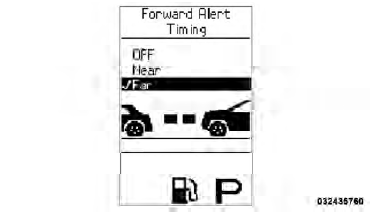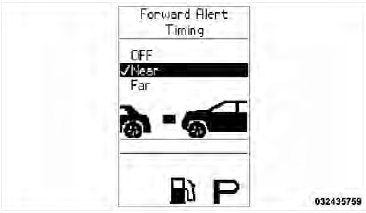Changing FCW Status
The FCW feature can be set to far, set to near or turned off in the Electronic Vehicle Information Center (EVIC) refer to “Electronic Vehicle Information Center (EVIC)” in “Understanding Your Instrument Panel” for further information.
The FCW Status Off, Near or Far will be displayed in the EVIC.
FCW settings can only be changed when the vehicle is in PARK.
The default status of FCW is the “Far” setting, this allows the system to warn you of a possible collision with the vehicle in front of you when you are farther away. This gives you the most reaction time.

Example Only
Changing the FCW status to the “Near” setting, allows the system to warn you of a possible collision with the vehicle in front of you when you are much closer. This setting provides less reaction time than the “Far” setting, which allows for a more dynamic driving experience.

Example Only
Changing the FCW status to “Off” prevents the system from warning you of a possible collision with the vehicle in front of you.

Example Only
NOTE: In the “Off” setting FCW OFF will be displayed in the EVIC.

FCW Off Example
NOTE:
• The system will retain the last setting selected by the
driver after ignition shut down.
• FCW will not react to irrelevant objects such as overhead objects, ground reflections, objects not in the path of the car, stationary objects that are far away, oncoming traffic, or leading vehicles with the same or higher rate of speed.
• FCW will be disabled like ACC below with the unavailable screens.
See also:
How To Engage The Automatic Locking Mode
1. Buckle the combination lap and shoulder belt.
2. Grasp the shoulder portion and pull downward until
the entire belt is extracted.
3. Allow the belt to retract. As the belt retracts, you will
...
Opening Sunroof — Express
Press the switch rearward and release it within one-half
second and the sunroof will open automatically from any
position. The sunroof will open fully and stop automatically.
This is called “Ex ...
Safety
WARNING!
• Under-inflation increases tire flexing and can result in over-heating and tire
failure.
• Over-inflation reduces a tire’s ability to cushion shock. Objects on the road
and chuck ...


